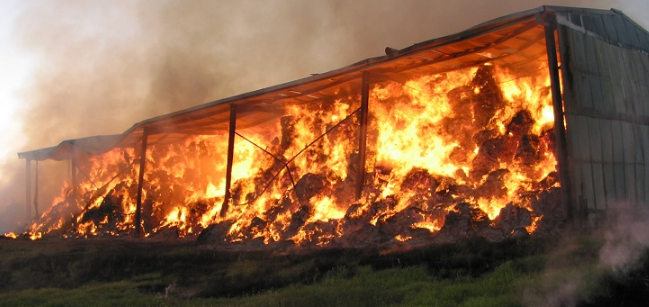Don't let your hay go up in smoke
 PRODUCTION ADVICE - SEPTEMBER 2020 - FODDER
PRODUCTION ADVICE - SEPTEMBER 2020 - FODDER
By Adrian Smith
Senior Land Services Officer - Mixed Farming Systems
Ph: 03 5881 9932 | M: 0447 778 515 | E: adrian.smith@lls.nsw.gov.au
 Now we are nearly mid-way through September, haymaking season is just ‘round the corner.
Now we are nearly mid-way through September, haymaking season is just ‘round the corner.
With many producers thinking about boosting their (depleted or non-existent) fodder reserves, it is timely to consider some of the issues around making hay.
There is (hopefully) the prospect of plenty of forage conservation opportunities with the abundance of feed in places this year.
But producing hay can be a risky proposition at the best of times! And this year may prove particularly challenging, given the forecast of above-average rainfall into late spring, the abundance of feed, and pressure on contractors – curing hay properly may become a real challenge.
There are two causes of hay shed fires – straight out accidents or spontaneous combustion, where moist hay produces enough heat to burn.
Photo caption: Courtesy NSW Rural Fires Service. Hay shed fires can be costly, both in terms of lost conserved fodder and the infrastructure that protects it.
Spontaneous combustion
This can occur where there are high moisture levels in hay. Natural processes such as the production of moulds and other chemical reactions lead to the production of heat. If enough oxygen is present in conjunction with enough heat, the hay can get hot enough to ignite.
As a general rule, hay with more than 16-18 per cent moisture content is at risk of going mouldy and producing heat. Over 20 per cent moisture and the risk increases, and at moisture contents above 25 per cent, there is a significant chance of spontaneous combustion.
Impacts of heating on feed quality?
If hay becomes too hot, feed quality (particularly protein levels) will be affected, with energy levels and digestibility also being negatively impacted.
The production of moulds can also have toxic impacts on livestock, cause respiratory problems for both humans and livestock and reduce the palatability of the feed.
What to be wary of?
- Making hay early in the season often means days are still relatively short, and as a consequence, curing times can be significantly longer. This also increases the risk of lower quality hay, or weather damage. Balancing the curing and quality constraints is vital.
- High levels of water-soluble sugars in plants can support greater levels of microbial growth if moisture levels are high.
- Paddocks that are cut without conditioning – particularly where there is a lot of dry matter – can be difficult to dry down within the centre of windrows. Mower conditions split and crush the plant stems, allowing crops to dry quicker and more evenly.
What can you do to minimise the likelihood of spontaneous combustion?
- Bale at the correct moisture content. Check by either visual examination of plants in the windrow (will the stems ‘snap’ easily, is there moisture still in the plant stems/nodes?) or using electronic moisture meters or probes. Experienced operators can provide a very accurate assessment – if using moisture probes, make sure they are calibrated to ensure accuracy and reliability in measurements.
- Use hay additives to reduce or prevent mould growth and therefore reduce the risk of heating. These additives are typically propionic acid, which acts to reduce microbial development, or antioxidants, which eliminate oxygen.
- Inoculants are for silage, as there is no fermentation in baled hay.
- If you think you may have a problem, check your hay stacks regularly by looking for signs of heating. Heating can occur from the time of baling through to 2-3 months afterwards. However, any moisture - such as that from a leaking shed - which infiltrates the stack can lead to heating and fire at any time.
- If you suspect your hay is heating up, be careful. Walking on a stack can cause it to collapse, especially if the centre is hot and has burnt out a cavity.
- If moving ‘hot’ bales from the stack, remember that exposure to oxygen can quickly cause ignition.
- Adequate ventilation is essential – around stacked bales and through the entire stockpile.
What other things should I consider?
- Make sure you have adequate insurance covering both your hay sheds and the fodder itself. Do not assume because your hay shed is insured that the contents are as well. Check with your insurer.
- Be aware of your insurance status - some insurers may not cover any loss of machinery that was stored in hay sheds that burn. Either don’t store machinery in with your hay, or ensure your policy will adequately cover any such machinery damaged in a hay fire.
- Be aware of any chemical residue/stock withholding periods as the result of chemicals that may have been applied to crops, which are now to be consumed by livestock - ask for a commodity vendor declaration.
- Nitrate poisoning – crops under stress (in particular canola) can have elevated nitrate levels which can poison and kill livestock – and the baling process will not reduce these levels (ensiling can reduce nitrate levels). Testing of nitrate levels in failed crops may be beneficial.
- Be aware of the potential to import weed seeds if buying in hay from elsewhere.
Bottom line
Ensure as much as possible that your hay is cured correctly before baling. The earlier in the season, generally the more difficult (and longer) this is. Check the moisture content of your windrows. Monitor any stacks you think may be heating up – and take action before it all goes up in smoke.
One final thing to ponder - this may be the year to consider silage as an option. Making silage (correctly) can often lead to production of a higher quality product with less risk of weather damage. However, it doesn’t come without risk, and does cost more to produce!